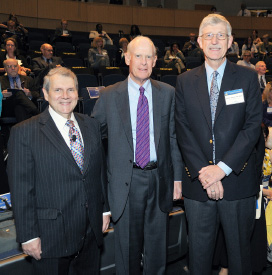NIAMS Celebrates Turning 25

Ernie Branson
NIAMS Director Stephen Katz (left), Research!America Chair John Porter (center), and NIH Director Francis Collins helped NIAMS celebrate its 25th anniversary.
The National Institute of Arthritis and Musculoskeletal and Skin Diseases (NIAMS) marked its 25th anniversary with a scientific symposium to commemorate a quarter-century of research, training, and information dissemination in disease areas that affect nearly every home in America. NIH Director Francis Collins, NIAMS Director Stephen Katz, Research!America Chairman John Edward Porter, and panels of patients, scientists, and clinicians reminisced about NIAMS to a packed Lipsett Amphitheater in June.
In his opening remarks, Katz reminded everyone that the seeds of the institute were planted 60 years ago as an arthritis program in the National Institute of Arthritis and Metabolic Diseases. Reorganizations led to the Division of Arthritis, Musculoskeletal, and Skin Diseases within the Institute of Arthritis, Diabetes, and Digestive, and Kidney Diseases, until, Katz joked, “We broke them off from us in 1986. They are still thriving today as the NIDDK.”
Collins praised NIAMS for making strides in developing treatments and understanding the pathophysiology and genetics of so many chronic and crippling diseases.
“We now know the molecular bases of about 4,000 diseases,” he noted. “We knew only a few dozen back when NIAMS was getting started. But of those 4,000 [diseases], we currently have effective treatments only for about 200.” He added, “We have the chance to focus even more intentionally now on taking the deluge of basic science discoveries pouring out of laboratories across all of the diseases that are in NIAMS’ portfolio and making sure that we apply those as quickly as possible in the translational arena.”
Both Porter, who served two decades in the U.S. House of Representative representing Illinois, and Collins emphasized that researchers today need to share the compelling stories coming out of their labs.
During the panel sessions, NIH intramural program scientists credited the NIH culture—which promotes collegiality, intellectual rigor, and the flexibility to pursue one’s interests—with stimulating the discoveries flowing today from intramural laboratories.
NIAMS Scientific Director John O’Shea called NIH a place where “people come from around the world and give their heart and soul to tough problems.” He recalled cloning the gene for the tyrosine kinase Jak3 in the mid-1990s: “It was actually really hard to clone a gene then,” he said. “I literally read every base pair, base pair by base pair. . . . Now, of course, it takes just a few seconds.”
But that slow-going work paid off. In recent years, O’Shea’s team has collaborated with Pfizer to develop a Jak3 inhibitor, one of a new class of immunosuppressants that effectively blocks transplant rejection.
Daniel Kastner, formerly of NIAMS and now the scientific director of NHGRI, likewise recalled “the wonderful opportunities” that NIH afforded a young scientist. “I started in this area of research back in late ’85, when I saw a young man of Armenian ancestry with a lifelong history of episodes of arthritis that would last a week at a time, roughly once a month,” he said. “It was familial Mediterranean fever, at that time known simply to be a genetic disorder caused by a single recessive gene. But nobody knew what that gene was, or what it did, or even what chromosome it was on. But this was back at that wonderful time, the dawn of the Human Genome Project, when with positional cloning—that method in which if you could recruit a group of families, if you knew it was a single-gene disease—you could discover the gene, even if you didn’t know anything about it. Seeing the dramatic inflammatory phenotype that this man had, I thought: That’s for me! . . . The adventure was on.”
An evening dinner program, “Bringing Medicine and Science to the Public,” brought a twist with Katz interviewing National Public Radio’s own consummate interviewer Diane Rehm. They discussed her views on the public’s perception of medical research and her journey with the voice disorder spasmodic dysphonia.
Katz concluded the daylong event by thanking the Foundation for the NIH and the other organizations that made the symposium possible. “We believe in leveraging our resources with the other ICs, as well as with outside organizations and agencies,” he said. “In many ways, this is a celebration of their contributions also. We are really all celebrating because we’ve been in this together.”
NINR also celebrated its 25th anniversary this year. The NIH Catalyst will report on NINR research advances in an upcoming issue.
This page was last updated on Monday, May 2, 2022
